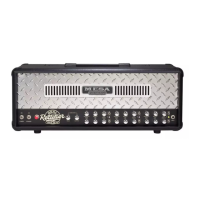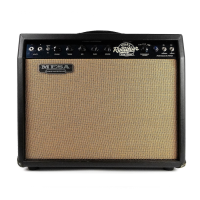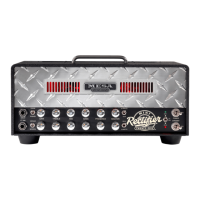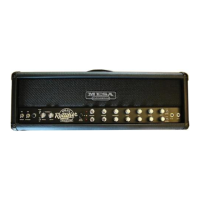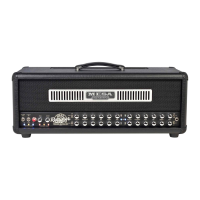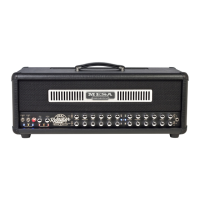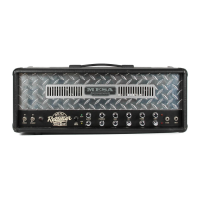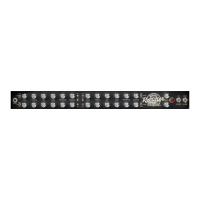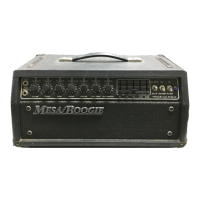6PAGE
MID
The MID Control is responsible for the blend of midrange frequencies in the mix and though its effect is not as dramatic
as that of the TREBLE Control, it plays an integral part in achieving any sound in your Recto. It is capable of changing the feel
dramatically as it blends in a group of frequencies that tend to soften or stiffen the way a
sound feels to play.
Most players tend to lean in the direction of lower MIDDLE Control settings (7:00 - 11:00)
where a scoop in this region produces girth by letting the Bass become a little more dominant.
Less punch lends a more compressed, even feel to the strings and therefore, a less appar-
ent resistance to the pick. As the MIDDLE Control is increased, (11:00 - 1:30) the sound is
rounded-out and filled-in with a focused midrange attack appearing rather quickly. As you
would guess, the feel starts to change – becoming slightly more resistant. Above this region the MIDDLE Control could be used
to compensate for either weaker pick-ups or for times when a specific deficiency is created either by an extremely high setting
of other tone controls, or a physical anomaly in the room. While these MIDDLE Control settings (2:00 - 5:00) can introduce
added gain and create enhanced focus, the trade-off may be a stiffer, more forward, less compressed feel.
Channel 1 utilizes a different MIDDLE Control than that of Channel 2 with a custom-designed taper and value. In its low range
(below 12:00) it functions as a normal midrange control with a taper suited to blending fine increments of these frequencies.
Most players lean toward a fairly radical scoop (7:00 - 10:30) for clean playing, preferring to let Treble and Bass remain domi-
nant, thus producing the signature sparkle and breath essential for a pristine clean sound.
As Channel 1’s MIDDLE Control is swept past 12:00, it starts to add gain in these midrange frequencies, adding cut and punch.
As the top end of the control is reached, (3:00 - 5:00) it becomes an additional gain control capable of taking both CLEAN and
PUSHED modes to extremes. Experiment with this cranked region in conjunction with conservative settings of the other tone
controls to balance both sound and feel. While this added flexibility may make Channel 1’s MIDDLE Control a little more tricky
to learn at first, it will become quite valuable as you start to realize the power of this super-versatile channel.
BASS
Last, but not least in the string of Tone controls, we come to the BASS. This control works similarly in both channels in
that it determines the amount of low frequencies present in a sound. However, the actual frequencies and style of lows it mixes
in changes with the channels. Like the MIDDLE Control, it falls in line signal-wise after the TREBLE
Control and the same scheme applies. When the TREBLE Control is set high, the effectiveness of the
BASS and MIDDLE Controls is reduced. If the TREBLE Control is set low, these two controls become
dominant.
For the most balanced sound and a balance of power between the three rotary Tone controls, try to
use the TREBLE Control in its middle ranges. This scenario produces nearly equal representation of all
the frequencies on the Tone controls and provides a great neutral starting point for further tweaking.
While the Recto-Verb 25’s EL-84 power section is not capable of delivering the massive amount of
bass frequencies that the big Rectos do with their 6L6 power tubes, it is still worth mentioning to
use the BASS control with finesse. Too high a BASS setting can cause a bloated, flubby attack and
create a sound that is unbalanced and even downright bad. A good rule to use as a guideline is this: as the GAIN is increased,
the BASS should be decreased. The higher GAIN settings add fullness and warmth - and bass - allowing you to get away with
lower BASS settings. Another thing that high settings of the BASS does is to eat up headroom. Low frequencies take more
power to deliver at a given volume than high frequencies due to their longer wave length. Your amp will clip sooner if there is a
large amount of bass it has to amplify. This is most noticeable in Channel 1 in the CLEAN Mode when looking for clean rhythm
sounds. The highest headroom is attained for clean chording by keeping the GAIN and BASS not far above 12:00 - somewhere
between 11:00 and 12:30. This will ensure that you are not “loading up” the front end with too much GAIN or low-end. Any
clipping you experience will most likely come from the tubes reaching their limit of power.
PRESENCE
This Control handles high frequency attenuation that is above that of the TREBLE control and its location in
the circuit moves depending on the Channel and Mode you have called up. In some Modes it’s a roll-off control at the end of
the preamp, in others it controls the amount of Negative Feedback at a given frequency in the power section. It acts indepen-
SCOOPED AND
EASY TO PLAY
ADDS PUNCH TO
WEAKER PICK-UPS
BASS
VARIABLE ACCORDING
TO TREBLE & MID CONTROL
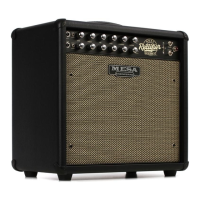
